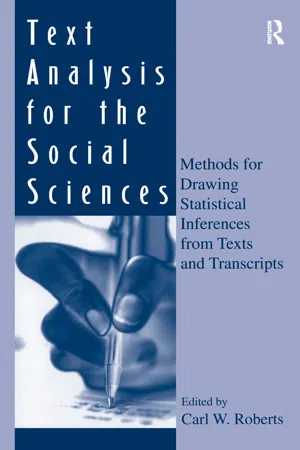
Text Analysis for the Social Sciences
Methods for Drawing Statistical Inferences From Texts and Transcripts
- 326 pages
- English
- ePUB (mobile friendly)
- Available on iOS & Android
Text Analysis for the Social Sciences
Methods for Drawing Statistical Inferences From Texts and Transcripts
About This Book
This book provides descriptions and illustrations of cutting-edge text analysis methods for communication and marketing research; cultural, historical-comparative, and event analysis; curriculum evaluation; psychological diagnosis; language development research; and for any research in which statistical inferences are drawn from samples of texts. Although the book is accessible to readers having no experience with content analysis, the text analysis expert will find substantial new material in its pages. In particular, this collection describes developments in semantic and network text analysis methodologies that heretofore have been accessible only among a smattering of methodology journals. The book's international and cross-disciplinary content illustrates the breadth of quantitative text analysis applications. These applications demonstrate the methods' utility for international research, as well as for practitioners from the fields of sociology, political science, journalism/communication, computer science, marketing, education, and English. This is an "ecumenical" collection that contains applications not only of the most recent semantic and network text analysis methods, but also of the more traditional thematic method of text analysis. In fact, it is originally with this volume that these two "relational" approaches to text analysis are defined and contrasted with more traditional "thematic" text analysis methods. The emphasis here is on application. The book's chapters provide guidance regarding the sorts of inferences that each method affords, and up-to-date descriptions of the human and technological resources required to apply the methods. Its purpose is as a resource for making quantitative text analysis methods more accessible to social science researchers.
Frequently asked questions
Information
CHAPTER
1
A Matter of Definition
John Markoff
University of Pittsburgh
The Need For Definition
Representative Definitions
Bernard Berelson: “Content analysis is a research technique for the objective, systematic, and quantitative description of the manifest content of communication” (Berelson, 1954, p. 489).3Dorwin Cartwright “In the subsequent discussion, we propose to use the terms ‘content analysis’ and ‘coding’ interchangeably, to refer to the objective, systematic, and quantitative description of any symbolic behavior” (Cartwright, 1953, p. 424).4Irving L. Janis: “ ‘Content analysis’ may be defined as referring to any technique a) for the classification of the sign-vehicles, b) which relies solely upon the judgments (which, theoretically, may range from perceptual discrimination to sheer guesses) of an analyst or group of analysts as to which sign-vehicles fall into which categories, c) on the basis of explicitly formulated rules, d) provided that the analyst’s judgments are regarded as the reports of a scientific observer” (Janis, 1949, p. 55 [emphases in original]).
Klaus Krippendorff: “These observations suggest that content analysis be restricted to the use of replicable and valid methods for making specific inferences from text to other states or properties of its source” (Krippendorff, 1969, p. 70).5Charles E. Osgood. “If we define content analysis as a procedure whereby one makes inferences about sources and receivers from evidence in the messages they exchange, then the problem falls precisely in the field of special interest of the psycholinguist” (Osgood, 1959, p. 35).Philip J. Stone: “Content analysis is any research technique for making inferences by systematically and objectively identifying specified characteristics within text” (Stone, Dunphy, Smith, & Ogilvie, 1966, p. 5).6
What classes of symbolic objects are studied in content analysis? | |
|---|---|
Text Only | Text and Other Symbolic Material |
Krippendorff Stone | Berelson (“communication”) Cartwright (“symbolic behavior”) Janis (“sign-vehicles”) Osgood (“messages”) |
What kind of intellectual product comes from a content analysis? | ||
|---|---|---|
Description | Inference | Classification |
Berelson | Krippendorff | Janis |
Cartwright | Osgood | |
Stone | ||
Table of contents
- Cover
- Half Title
- Title Page
- Copyright Page
- Dedication
- Table of Contents
- Introduction
- 1 A Matter of Definition
- PART I: METHODOLOGIES
- PART II: APPLICATIONS
- PART III: PROSPECTS
- References
- Author Index
- Subject Index